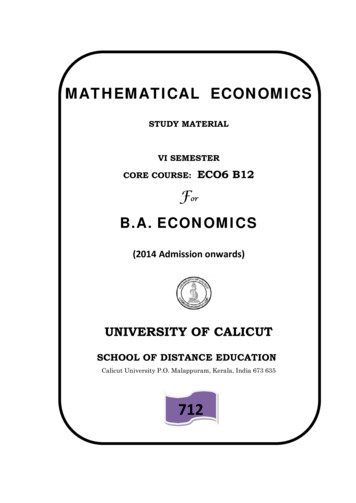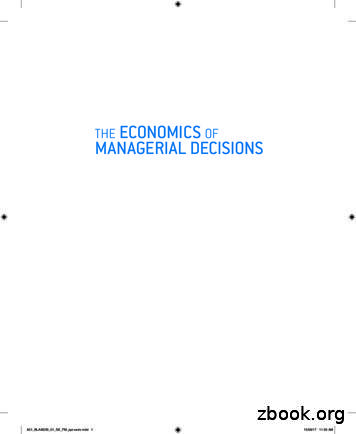Mathematical Economics - Aktualności
Mathematical EconomicsDr Wioletta Nowak, room 205 /user/12141/students-resources
SyllabusMathematical Theory of DemandUtility Maximization ProblemExpenditure Minimization ProblemMathematical Theory of ProductionProfit Maximization ProblemCost Minimization ProblemGeneral Equilibrium TheoryNeoclassical Growth ModelsModels of Endogenous Growth TheoryDynamic Optimization
SyllabusMathematical Theory of Demand Budget ConstraintConsumer PreferencesUtility FunctionUtility Maximization ProblemOptimal ChoiceProperties of Demand FunctionIndirect Utility Function and its PropertiesRoy’s Identity
SyllabusMathematical Theory of Demand Expenditure Minimization ProblemExpenditure Function and its PropertiesShephard's LemmaProperties of Hicksian Demand FunctionThe Compensated Law of DemandRelationship between Utility Maximization andExpenditure Minimization Problem
SyllabusMathematical Theory of Production Production Functions and Their Properties Perfectly Competitive Firms Profit Function and Profit MaximizationProblem Properties of Input Demand and OutputSupply
SyllabusMathematical Theory of Production Cost Minimization Problem Definition and Properties of Conditional FactorDemand and Cost Function Profit Maximization with Cost Function Long and Short Run Equilibrium Total Costs, Average Costs, Marginal Costs,Long-run Costs, Short-run Costs, Cost Curves,Long-run and Short-run Cost Curves
SyllabusMathematical Theory of ProductionMonopolyOligopoly Cournot Equilibrium Quantity Leadership – Slackelberg Model
SyllabusGeneral Equilibrium Theory Exchange Market Equilibrium
SyllabusNeoclassical Growth Model The Solow Growth Model Introduction to Dynamic Optimization The Ramsey-Cass-Koopmans Growth ModelModels of Endogenous Growth TheoryConvergence to the Balance Growth Path
Recommended Reading Chiang A.C., Wainwright K., Fundamental Methods ofMathematical Economics, McGraw-Hill/Irwin, Boston,Mass., (4th edition) 2005. Chiang A.C., Elements of Dynamic Optimization, WavelandPress, 1992. Romer D., Advanced Macroeconomics, McGraw-Hill, 1996. Varian H.R., Intermediate Microeconomics, A ModernApproach, W.W. Norton & Company, New York, London,1996.
The Theory of Consumer Choice The Budget Constraint The Budget Line Changes (Increasing Income,Increasing Price) Consumer Preferences Assumptions about Preferences Indifference Curves: Normal Good, PerfectSubstitutes, Perfect Complements, Bads, Neutrals The Marginal Rate of Substitution
Consumers choose the best bundle ofgoods they can afford How to describe what a consumer can afford? What does mean the best bundle? The consumer theory uses the concepts of abudget constraint and a preference map toanalyse consumer choices.
The budget constraint – the two-good case It represents the combination of goods thatconsumer can purchase given current pricesand income. x1 , x 2 , x i 0, i 1, 2 - consumer’sconsumption bundle (the object of consumerchoice) p1 , p 2 , p i 0, i 1, 2- market pricesof the goods
The budget constraint – the two-good case The budget constraint of the consumer (the amount ofmoney spent on the two goods is no more than the totalamount the consumer has to spend)p1x1 p 2 x 2 I I 0 - consumer’s income (the amount of money theconsumer has to spend)p1x1 - the amount of money the consumer is spending on good 1p 2 x 2 - the amount of money the consumer is spending on good 2
Graphical representation of the budget set and the budget line The set of affordable consumption bundles atgiven prices and income is called the budget setof the consumer.
The Budget Line
The Budget Line Changes Increasing (decreasing) income – an increase (decrease) inincome causes a parallel shift outward (inward) of the budgetline (a lump-sum tax; a value tax)
The Budget Line Changes Increasing price – if good 1becomes more expensive,the budget line becomessteeper. Increasing the price of good1 makes the budget linesteeper; increasing the priceof good 2 makes the budgetline flatter. A quantity taxA value tax (ad valorem tax)A quantity subsidyAd valorem subsidy
Exercise 1
Consumer Preferences
Consumer PreferencesPs ( x, y) X X x y relation of strict preferenceI ( x, y) X X x y relation of indifference P ( x, y) X X x y relation of weak preference
Assumptions about Preferences
Assumptions about Preferences
Assumptions about Preferences
Assumptions about Preferences
The relations of strict preference, weak preference andindifference are not independent concepts!
Exercise 2
Exercise 3
Indifference Curves The set of all consumption bundles that areindifferent to each other is called anindifference curve. Points yielding different utility levels are eachassociated with distinct indifference curves.
Indifference curves are
Indifference curve for normal goods
Perfect substitutes Two goods are perfectsubstitutes if the consumeris willing to substitute onegood for the other at aconstant rate. The simplest case of perfectsubstitutes occurs when theconsumer is willing tosubstitute the goods on aone-to-one basis. The indifference curves hasa constant slope since theconsumer is willing to tradeat a fixed ratio.
Perfect complements Perfect complements aregoods that are alwaysconsumed together infixed proportions. L-shapedcurves.indifference
Bads: a bad is a commodity that consumer doesn’t like
Neutrals: a good is a neutral good if the consumerdoesn’t care about it one way or the other
The Marginal Rate of Substitution (MRS) The marginal rate of substitution measures the slope of theindifference curve.
The Marginal Rate of Substitution (MRS)
The Marginal Rate of Substitution (MRS) The MRS is different at each point along theindifference curve for normal goods. The marginal rate of substitution betweenperfect substitutes is constant.
Mathematical Economics Dr Wioletta Nowak, room 205 C . Mathematical Theory of Production . Fundamental Methods of Mathematical Economics, McGraw-Hill/Irwin, Boston, Mass., (4th edition) 2005. Chiang A.C., Elements of Dynamic Optimization, Waveland Press, 1992.
zaka državne granice na području Cve-tlina i Jamna, no usprkos tome granič-na policija sukladno vlastitim analizama . stručnjake za zgrade gotovo nulte energije Od 2021. godine sve novoizgrađe-ne zgrade privatnih, a v
2. Dowling E.T, Introduction to Mathematical Economics, 2nd Edition, Schaum’s Series, McGraw-Hill, New York, 2003(E TD) 3. R.G.D Allen, Mathematical Economics 4. Mehta and Madnani -Mathematics for Economics 5. Joshi and Agarwal-Mathematics for Economics 6. Taro Yamane-Mathematics for Economics 7. Damodar N.Gujarati, Basic Econometrics, McGraw .
Std. 12th Economics Smart Notes, Commerce and Arts (MH Board) Author: Target Publications Subject: Economics Keywords: economics notes class 12, 12th commerce, 12th economics book , 12th commerce books, class 12 economics book, maharashtra state board books for 12th, smart notes, 12th std economics book , 12th economics book maharashtra board, 12th economics guide , maharashtra hsc board .
International Finance 14. Development Policy 15. Institutional Economics 16. Financial Markets 17. Managerial Economics. 13 18. Political Economy 19. Industrial Economics 20. Transport Economics 21. Health Economics 22. Experimental and Behavioral Economics 23. Urban Economics 24. Regional Economics 25. Poverty and Income Distribution
Lecture notes based mostly on Chiang and Wainwright, Fundamental Methods of Mathematical Economics. 1 Mathematical economics Why describe the world with mathematical models, rather than use verbal theory and logic? After all, this was the state of economics until not too long ago (say, 1950s
mathematical economics has led to conceptual advances in economics. 1.1.2 Advantages of Mathematical economics (1 ) The ‘language’ used is more concise and precise (2 ) a number of mathematical theorems help us to prove or disprove economic
Labor Economics, Public Economics, Applied Econometrics, and Economics of Education Tia Hilmer, Professor O ce: NH-317, Email: chilmer@sdsu.edu Econometrics, Natural Resources, Environmental Economics . Mathematical Economics (3) Prerequisite: Mathematics 124 or 150. Recommended: Economics 320 or 321. .
Managerial Economics Klein Mathematical Methods for Economics Krugman/Obstfeld/Melitz International Economics: Theory & Policy* Laidler The Demand for Money Lynn Economic Development: Theory and Practice for a Divided World Miller Economics Today* Miller/Benjamin The Economics of Macro Issues Miller/Benjamin/North The Economics of Public Issues .























